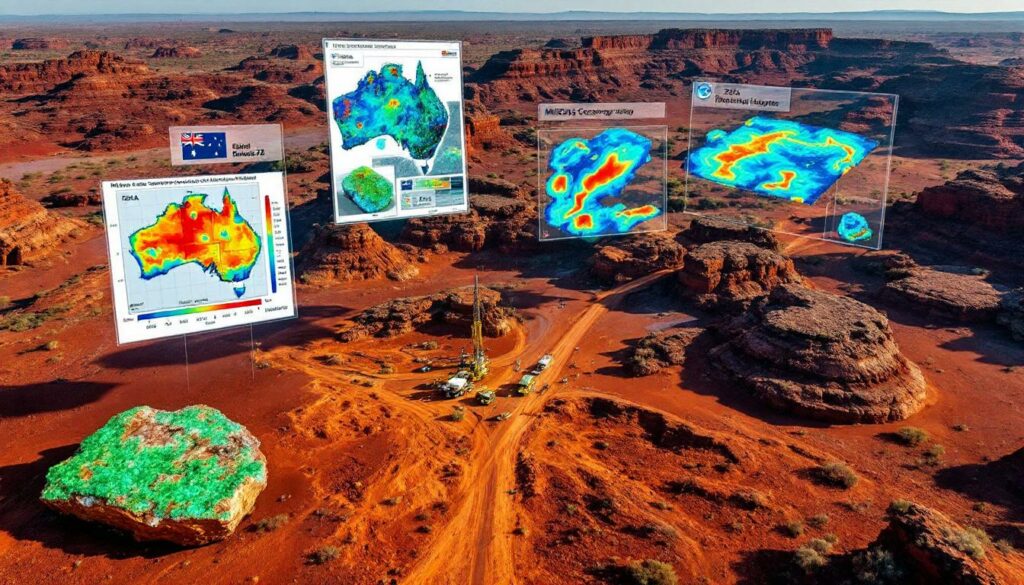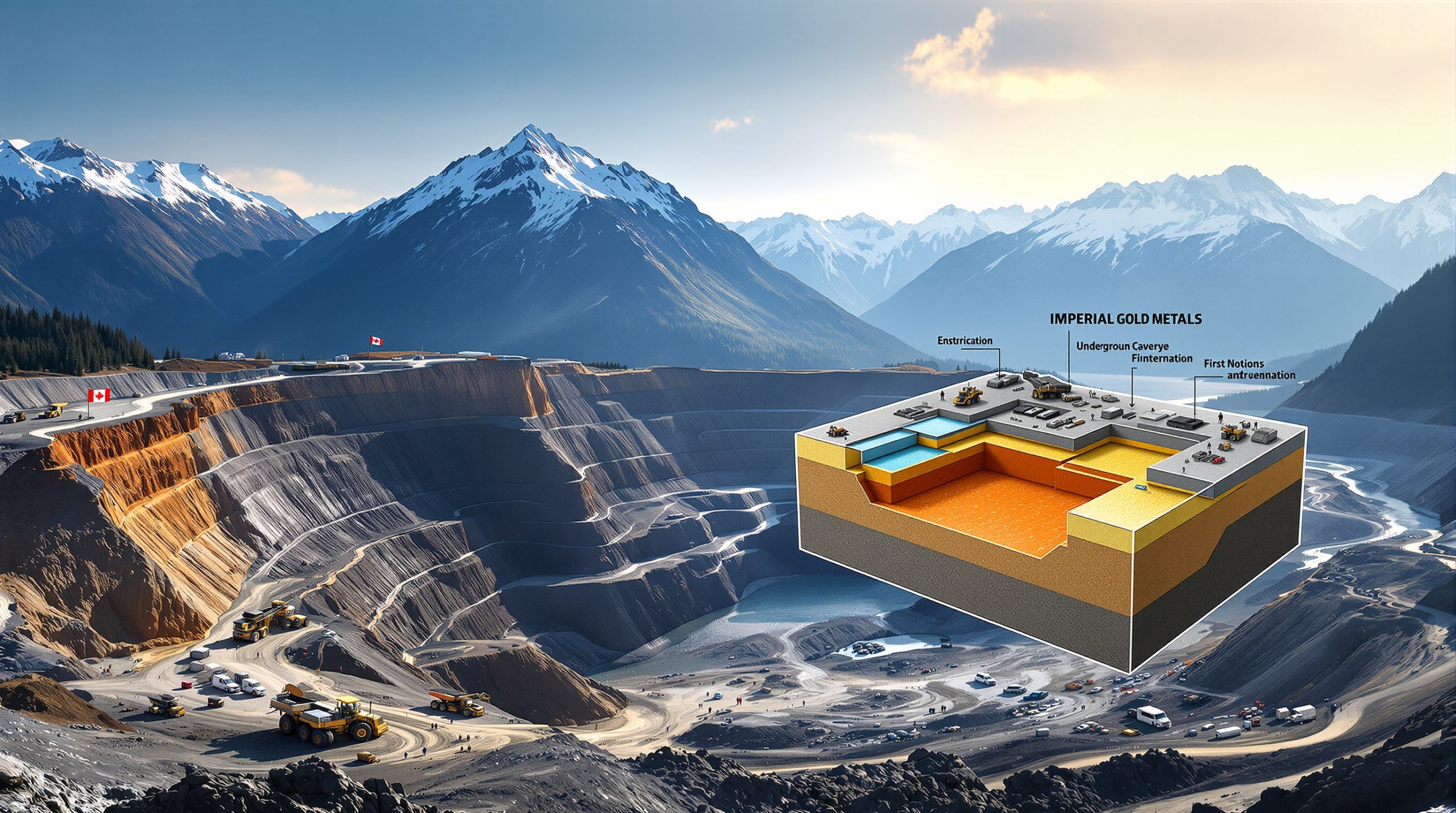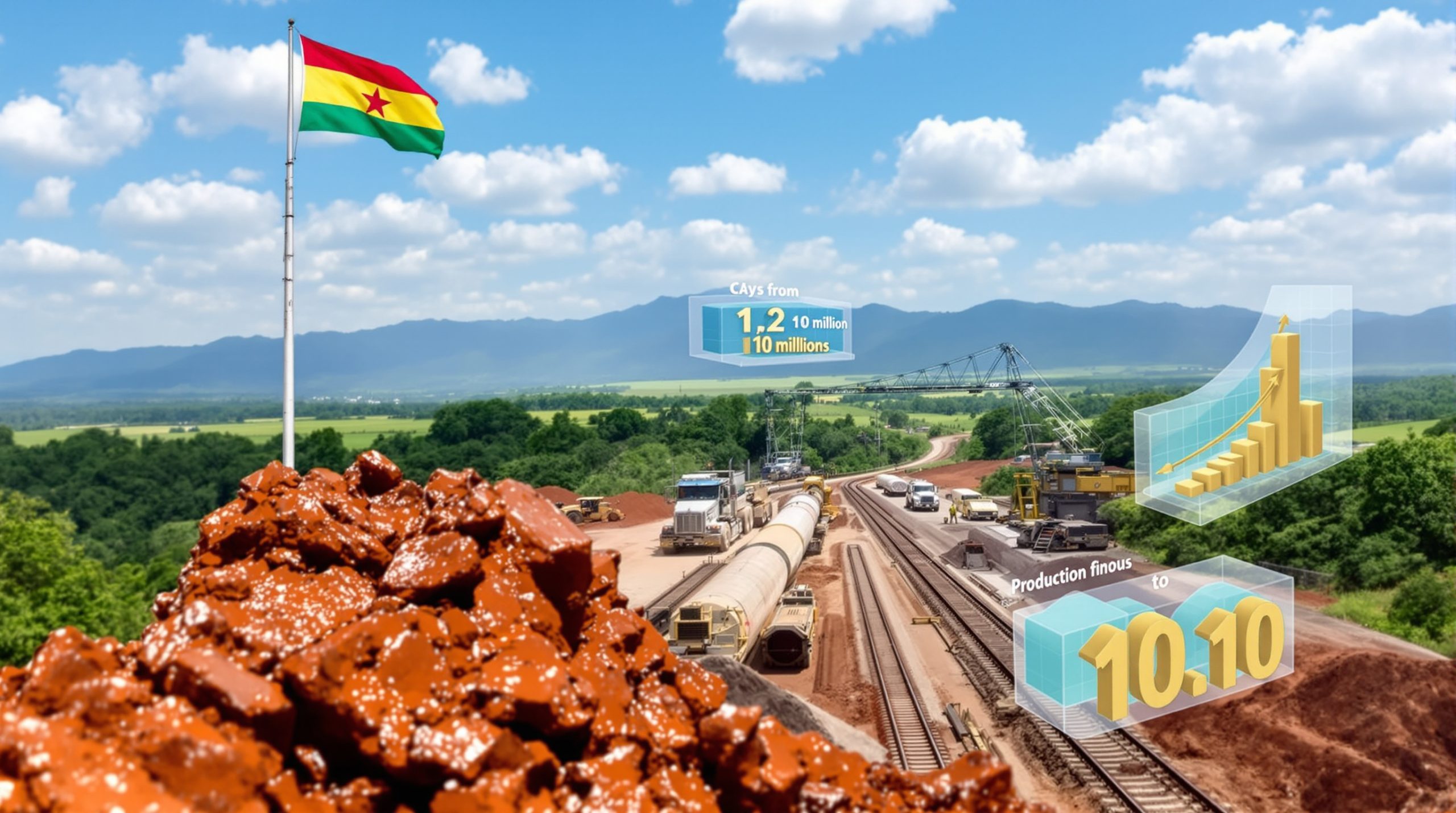What is the Jessica Copper Project and Why Does it Matter?
The Jessica Copper Project represents one of Australia's most promising copper exploration opportunities, spanning a vast 8,700 square kilometer area east of Tennant Creek in the Northern Territory. This strategic partnership between junior explorer Encounter Resources (ASX: ENR) and mining giant South32 (ASX: S32) was established in 2022, combining complementary expertise to unlock the region's significant mineral exploration importance.
The project area is uniquely positioned to host two distinct deposit types: sediment-hosted copper systems similar to those found in the Central African Copperbelt, and iron oxide copper-gold (IOCG) deposits comparable to Olympic Dam in South Australia. This dual prospectivity significantly enhances the project's discovery potential.
"The Jessica Project is strategically positioned along key structural corridors in a historically productive mining region," notes Will Robinson, Executive Chair of Encounter Resources. "Our systematic exploration approach has already identified multiple indicators of significant mineralization."
The Strategic Northern Territory Copper Exploration Joint Venture
The Jessica Project sits in an underexplored region of the Northern Territory that shares geological similarities with some of the world's most productive copper provinces. Historical mining operations around Tennant Creek have primarily focused on gold, leaving substantial copper potential largely untested using modern exploration techniques.
The partnership structure between Encounter and South32 exemplifies a successful junior-major collaboration model. South32 provides the financial resources and technical capabilities of a global mining company, while Encounter contributes regional expertise and exploration innovation. This balanced approach allows for sustained, systematic exploration across the extensive project area.
What makes this joint venture particularly noteworthy is its positioning along key structural corridors that control mineralization in the region. These deep-seated structures serve as conduits for mineralizing fluids and are critical for the formation of major copper deposits.
Significance in Australia's Copper Exploration Landscape
The Jessica Project has taken on increased importance within Australia's critical minerals strategy. As global demand for copper continues to accelerate due to the renewable energy transition and electrification trends, discovering new domestic copper resources has become a national priority.
According to industry analysts, the world will need to discover the equivalent of one major copper deposit annually to meet projected demand growth. Australia, with its stable regulatory environment and established mining infrastructure, is ideally positioned to help address this supply gap.
The Northern Territory government has recognized this potential, providing co-funding support through the NT Geophysics and Drilling Collaborations program. This support underscores the strategic importance of the Jessica Project within Australia's broader copper investment landscape.
From an investment perspective, the partnership model employed at Jessica represents a risk-balanced approach to frontier exploration. While Encounter's shareholders maintain significant exposure to discovery upside, the South32 farm-in agreement minimizes dilution and financial risk during the capital-intensive exploration phase.
What New Exploration Activities Have Been Announced?
The Jessica Copper Project is entering an exciting new phase of exploration activity, with a comprehensive program designed to systematically test priority targets identified through previous work. This multi-faceted approach combines cutting-edge geophysical technologies with targeted drilling program approaches to maximize discovery potential.
Comprehensive 2025 Geophysical Program
A MIMDAS (Multiple Input Multiple Output Distributed Array System) geophysical survey is now underway at the Zeta target, representing a significant advancement in the project's exploration capabilities. This sophisticated technology is particularly effective for exploring deep targets and detecting the types of mineralization associated with IOCG systems.
"MIMDAS is well suited for exploring at depth for less conductive bodies such as IOCG deposits," explains Will Robinson. "Unlike massive sulfide deposits, IOCG systems often have lower conductivity, making them more difficult to detect with conventional electromagnetic methods."
The MIMDAS survey will be complemented by an extensive 2,640km airborne electromagnetic survey scheduled for August-September 2025. This regional-scale survey will help identify conductive bodies across the broader project area, potentially highlighting additional targets for follow-up investigation.
Significantly, the exploration program has secured co-funding from the Northern Territory Geophysics and Drilling Collaborations program, reflecting the project's alignment with government priorities for resource development in the region.
Planned Diamond Drilling Campaign
Following the completion and interpretation of the geophysical surveys, a diamond drilling program is scheduled to commence in October 2025. This drilling will initially focus on the Zeta target, which has emerged as the highest priority based on earlier exploration results.
The drilling campaign has been strategically designed to test:
- The core of the Zeta gravity anomaly
- Coincident gravity and magnetic features
- Zones where previous drilling encountered alteration indicative of IOCG systems
- Areas where geophysical signatures suggest the presence of mineralized intrusive bodies
Diamond drilling has been selected over reverse circulation (RC) drilling to provide detailed geological information, including structural data, alteration patterns, and mineralization styles. This comprehensive dataset will be crucial for interpreting drill results and refining future targeting efforts.
How Did Previous Exploration Inform Current Activities?
The current exploration program at the Jessica Copper Project builds upon a foundation of systematic work conducted in 2024. These earlier activities have provided critical insights that have shaped the targeting approach and prioritization of areas for detailed investigation.
Key Findings from 2024 Exploration Work
Scout drilling completed in 2024 yielded several significant indicators of IOCG-style mineralization at the Zeta target. Most notably, drilling intercepted:
- Visible chalcopyrite and bornite (copper sulfide minerals) in quartz-carbonate veins
- Intense, pervasive red rock hematite alteration extending over significant intervals
- Zones of hydrothermal brecciation characteristic of IOCG systems
- Elevated pathfinder elements typically associated with copper mineralization
"The hematite alteration we've encountered is interpreted as a distal signature to a potential IOCG system," notes Robinson. "This style of alteration forms an important vector toward the core of mineralized systems in other major IOCG provinces globally."
While the 2024 drilling did not intersect economic mineralization, the alteration patterns and mineral assemblages encountered are consistent with the outer zones of IOCG deposits. These distal indicators provide valuable vectoring information, suggesting that higher-grade mineralization may be present in untested portions of the target.
Technical Advancements in Target Generation
A major technical advancement in 2024 was the reprocessing of seismic data to provide enhanced geological detail in the upper 1,000 meters. This reprocessing has significantly improved the team's understanding of the structural architecture controlling mineralization in the project area.
The exploration team also completed a large-scale gravity survey that identified several discrete density anomalies potentially associated with mineralization. The Zeta target emerged from this work as a particularly significant feature due to:
- Its discrete gravity signature indicating a dense body at depth
- Correlation with prominent magnetic features at the target margins
- Spatial association with a large interpreted intrusive complex
- Favorable structural positioning within a key corridor
The integration of these multiple datasets has allowed for more refined targeting than would be possible using any single exploration technique. This multi-disciplinary approach is particularly important for IOCG exploration, where mineralization can be expressed differently across various geophysical methods.
Why is the Zeta Target Considered Promising?
Among the multiple targets identified within the Jessica Project, Zeta has emerged as the highest priority based on a combination of geophysical characteristics, geological setting, and preliminary drilling results. Its features align closely with those observed at other significant IOCG deposits globally.
Geological Characteristics of the Zeta IOCG Target
The Zeta target is defined by a discrete gravity anomaly coincident with a prominent magnetic feature, a classic geophysical signature of IOCG systems. This combination typically reflects the presence of dense iron oxides (hematite/magnetite) associated with copper-gold mineralization.
What makes Zeta particularly interesting is its location on the margin of a large interpreted intrusive body. In IOCG systems worldwide, the margins of intrusives often represent favorable positions for mineralization due to:
- Enhanced permeability at the contact between different rock types
- Temperature gradients that promote efficient mineral precipitation
- Structural complexity that creates traps for mineralizing fluids
- Chemical interactions between magmatic fluids and host rocks
Previous drilling at Zeta encountered intense hematite alteration, which is considered a hallmark of the IOCG deposit model. While this alteration may represent the distal expression of the mineral system, it provides important vectoring information suggesting proximity to potential economic mineralization.
The structural setting of Zeta is also favorable, situated within a key corridor east of Tennant Creek where major regional structures intersect. These structural intersections often control fluid flow and create dilational zones where minerals can precipitate.
IOCG Deposit Exploration Methodology
The exploration approach at Zeta has been specifically tailored to the characteristics of IOCG deposits, which present unique challenges compared to other copper deposit types. Unlike volcanic-hosted massive sulfide (VHMS) deposits, which typically have strong electromagnetic responses, IOCG systems often lack massive sulfides and may be more difficult to detect using conventional EM techniques.
This is why the MIMDAS technology has been selected for the current survey. As Robinson explains: "MIMDAS provides superior resolution and depth penetration for detecting the subtle conductivity contrasts associated with IOCG mineralization."
The targeting methodology also incorporates lessons learned from other successful IOCG discoveries, including:
- The importance of gravity surveys for identifying dense hematite/magnetite bodies
- Recognition of regional-scale alteration halos that may extend beyond economic mineralization
- The role of structurally-controlled fluid pathways in localizing mineralization
- Correlation between multiple geophysical datasets to reduce false positives
By applying these principles at Zeta, the exploration team aims to efficiently vector toward potential economic mineralization while minimizing drilling in barren areas.
How is the Project Expanding?
The Jessica Copper Project has undergone significant expansion since its inception, reflecting the progressive understanding of the region's geological potential and the strategic acquisition of the most prospective ground. This growth strategy ensures comprehensive coverage of key mineralized corridors while maintaining focus on the highest-priority areas.
Strategic Land Position Growth
Following a detailed review of the 2024 drilling results and regional geophysical data, Encounter and South32 recently expanded the project footprint along several prospective structural corridors. This strategic acquisition has increased the total project area to approximately 8,700 square kilometers.
The expansion focused specifically on securing additional ground that:
- Extends coverage along interpreted deep-seated structures
- Captures extensions of identified geophysical anomalies
- Includes areas with favorable host rock sequences
- Encompasses regional alteration patterns identified through remote sensing
This systematic approach to land acquisition ensures that the project maintains control over the most prospective ground in the region while creating a cohesive exploration package that can be efficiently evaluated.
The scale of the land position is significant, providing sufficient area to potentially host multiple major deposits. This regional-scale approach is particularly important for sediment-hosted copper exploration, where mineralized systems can extend over tens of kilometers.
Farm-in Agreement Structure
The partnership between Encounter Resources and South32 follows a farm-in agreement structure that aligns the interests of both companies while managing exploration risk. Under this arrangement, South32 is wholly funding the initial exploration activities, allowing Encounter to maintain significant project exposure without the financial burden of early-stage work.
The key elements of the farm-in include:
- South32 funding exploration through to completion of a scoping study
- Encounter being "carried" through this capital-intensive phase
- Technical collaboration between both companies' geological teams
- Staged decision points that allow for program optimization
This structure represents a balanced risk-reward approach that leverages each company's strengths. Encounter contributes its exploration expertise and project generation capabilities, while South32 provides the financial resources and technical capacity of a major mining company.
The long-term partnership approach allows for sustained, systematic exploration rather than the rushed programs often necessitated by junior companies with limited funding. This patient capital is particularly valuable for frontier exploration in underexplored regions like the Northern Territory.
What Technologies and Methods Are Being Employed?
The Jessica Copper Project employs a sophisticated, multi-disciplinary exploration approach that integrates cutting-edge technologies with proven methodologies. This comprehensive strategy maximizes the probability of discovery while efficiently managing exploration resources.
Advanced Geophysical Techniques
At the forefront of the exploration toolkit is MIMDAS (Multiple Input Multiple Output Distributed Array System), a proprietary geophysical technology that combines induced polarization, resistivity, and magnetotelluric measurements. This advanced system provides several key advantages:
- Deeper penetration than conventional IP systems (potential to image targets >1km depth)
- Enhanced resolution of subtle conductivity variations typical of IOCG systems
- Ability to distinguish between different sources of conductivity (graphite vs. sulfides)
- 3D inversion capabilities that improve target visualization
The 2,640km airborne electromagnetic survey scheduled for August-September 2025 will complement the MIMDAS work by providing regional-scale conductivity mapping. This broader coverage helps identify new targets while placing the detailed MIMDAS results in their regional context.
Gravity and magnetic surveys form additional pillars of the geophysical program. Gravity data is particularly critical for IOCG exploration, as it effectively identifies the dense iron oxide accumulations that typically host copper-gold mineralization. Magnetic surveys highlight potential alteration systems and help delineate intrusive bodies that may be associated with mineralization.
These multiple geophysical datasets provide complementary information, allowing the exploration team to:
- Confirm targets through multiple independent methods
- Reduce false positives by requiring coincident anomalies
- Better understand the geological context of identified targets
- Prioritize drilling locations based on integrated interpretations
Integrated Exploration Approach
Beyond the technical aspects of individual surveys, the Jessica Project employs a holistic exploration methodology that integrates multiple data streams. This approach includes:
- Correlation of geophysical datasets to identify high-priority targets
- Geological interpretation informed by previous drilling results
- Structural analysis using reprocessed seismic data
- Geochemical vectoring based on pathfinder elements
- Alteration mapping to identify potential mineralized systems
This multi-disciplinary integration is coordinated through sophisticated 3D modeling software that allows geologists to visualize relationships between different data types. This spatial analysis helps identify patterns that might not be apparent when examining individual datasets in isolation.
The exploration process advances systematically from regional to prospect-scale, with each phase informing the next:
- Regional framework development through broad-scale geophysics
- Target generation using integrated datasets
- Target ranking based on multiple criteria
- First-pass testing of highest-priority targets
- Vector refinement based on initial results
- Focused follow-up on the most promising areas
This methodical approach ensures efficient use of exploration resources while maximizing the probability of discovery success.
What's Next for the Jessica Copper Project?
The Jessica Copper Project has entered an exciting phase of accelerated exploration activity, with a clear roadmap for both near-term milestones and longer-term development potential. This structured approach provides investors and stakeholders with visibility into the project's progression while maintaining flexibility to adapt to exploration results.
Near-Term Exploration Timeline
The immediate exploration program follows a logical sequence designed to progressively refine targets before committing to expensive drilling campaigns:
-
MIMDAS survey at Zeta (July-August 2025): Detailed geophysical characterization of the highest-priority target to optimize drill targeting.
-
Airborne electromagnetic survey (August-September 2025): Regional-scale conductivity mapping across 2,640 line kilometers to identify additional targets and place Zeta in its broader geological context.
-
Analysis and interpretation of geophysical data (September-October 2025): Integration of new datasets with existing information to refine drill targets and prioritize testing locations.
-
Diamond drilling program commencement (October 2025): Initial testing of the Zeta target based on the integrated geophysical interpretation, with flexibility to adjust the program based on preliminary results.
This sequential approach ensures that each activity builds upon previous results, creating a progressively more detailed understanding of the mineral system. The timeline also allows for efficient resource allocation, with the team focused on one major activity at a time.
"Our systematic approach to exploration is designed to maximize the probability of discovery while managing risk," explains Robinson. "Each phase provides valuable information that informs subsequent work, allowing us to vector toward the most prospective areas."
Long-Term Development Pathway
Beyond the immediate exploration program, the Jessica Project has a well-defined pathway toward potential development:
-
Target refinement: Following initial drilling results, the exploration team will refine their geological model and adjust targeting criteria for subsequent drilling campaigns.
-
Resource definition work: If initial drilling identifies significant mineralization, the program will transition toward systematic drilling to define the extent and grade of potential resources.
-
Progression toward scoping study: Under the farm-in agreement, South32 will fund activities through to the completion of a scoping study, providing a preliminary assessment of development options and economic parameters.
-
Project expansion opportunities: The extensive land position provides numerous opportunities to identify additional targets beyond Zeta, potentially creating a pipeline of exploration prospects.
Disclaimer: Mineral exploration is inherently uncertain, with no guarantee of discovery success. The timeline and development pathway outlined above represent the current plan but may be modified based on exploration results and changing
Ready to Spot the Next Major Copper Discovery?
Stay ahead of the market with real-time alerts on significant ASX mineral discoveries through Discovery Alert's proprietary Discovery IQ model, turning complex geological data into actionable investment insights. Explore why major mineral discoveries like the Jessica Copper Project can lead to substantial returns by visiting Discovery Alert's dedicated discoveries page.




